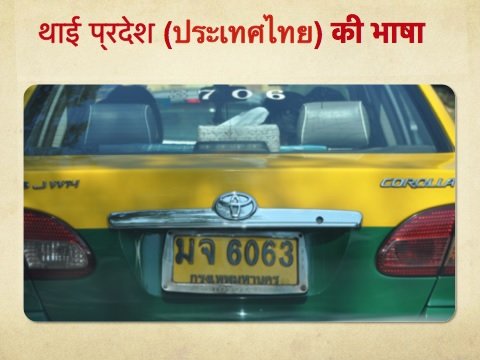Recently, Uma Bharti remarked on the need to propagate Indian languages and how English becomes a barrier. Predictably, people on English news portals jumped on her remarks.
Sample a comment on one such portal:

There are some enduring myths about the English language in India, particularly in association to “progress”, “technology” and “modernity”. As someone who went to an English-medium school in India, I myself subscribed to these myths. It was only when I travelled the world, to over 30 countries, that I realised our assumptions about English are that of frogs in a well.
When I was a manager at Microsoft, I visited my team at the Microsoft development centre in Israel. This was eye-opening. I later spent a summer travelling in Indian villages and I realised the real cost of our assumptions about English. Contrary to the notions I had about English being necessary for science and technology or for India’s progress, I came to realise that India’s English-medium obsession is one of the biggest barriers to India’s development.
Here then are 5 enduring myths about English:

- Myth 1: English is a language spoken by all well-educated, developed, technically-savvy people in the world
There are millions of people in the world who are well-off, well-educated and technically savvy and they don’t speak a word of English. When I was in South Korea, I found it to be an affluent country. However, it was nearly impossible to find someone who spoke English apart from the staff of the luxury hotel I was staying in. In China, I found a tech-savvy population and a proliferation of high-end iPhones. Yet, even at a fancy restaurant in Beijing, I found that not one person—from the wait-staff to the manager—spoke a word of English. I can’t imagine something like this happening in India. The staff at the Chinese restaurant asked me to type my order into their smartphone. They then used the Baidu app to translate it to Chinese.

- Myth 2: MNCs do all their business in English; English is necessary for an MNC job
MNCs in all major countries operate in the local language. When I was at Microsoft Development Center in Haifa, Israel, I was surprised to find that the language of communication was Hebrew, not English. Emails were in Hebrew, technical documents and discussions were all in Hebrew. This, when the entire population of Israel is less than that of Delhi. Similarly, Samsung, which is one of the biggest electronics manufacturer in the world with cutting-edge technology has a CEO who did his MBA in Korean. Samsung uses Korean in South Korea, uses Thai for office jobs in Thailand, but in India it uses English. MNCs choose to adapt in different countries of the world but in India, we bend backwards assuming MNC means English.

- Myth 3: English is India’s “competitive advantage” and necessary to develop India
This is the most enduring myth—that English has given India a “competitive advantage” in Information Technology. There are highly technically advanced societies, such as Japan, that do not use English. Some years ago I travelled to Indian villages armed with IQ tests. I found, to my surprise, that rural children outscored urban Indian children in IQ. English, as the language of higher and professional education alienates these children. They find math easy but English hard.

Even when it comes to outsourcing, the advantage is temporary. China’s programmers learn in Chinese and have teams with one outward-facing project liaison who speaks the client language. Thus, China is providing outsourcing to the US, using English, but also to Japan, using Japanese. Only about 5% of the world’s population is native English speakers and the importance of this segment will likely decline as the US and the UK decline as Economic superpowers. China is also investing in technological innovation, developing its own companies, like Baidu and Weibo for search and social networking while its entire technology education uses Chinese.
- Myth 4: Indian languages are “not suitable” for science and technology education
Science is taught at the graduate level in dozens of languages across the world, from Japanese to Portuguese and from Thai to Polish. It is even written using the pictographic Kanji (Japanese writing system) script with thousands of characters. Even MS-DOS the command prompt operating system from Microsoft supported Kanji characters 30 years ago because the Japanese demanded it.

Indian languages, on the contrary, are highly scientific. They are phonetically sound and can express a range of sounds. They also have technical literatures and vocabulary from hundreds of years. Sanskrit-based grammars also makes it very easy to construct new words.
Hebrew was once considered a dead language, yet it was revived for science and technology education. Technion, Israel’s foremost engineering college is Hebrew-medium and is ranked much higher than the IITs. Languages need investment. India simply needs to invest in its languages and keep them contemporary. It is much easier to translate one thousand key books of science and technology than teach a foreign language to a billion plus people.

- Myth 5: People want English, but the government keep pushing Hindi/Indian languages
It is, in fact, the other way round. It is English that is pushed in India by government policy. The government allows only English in the Supreme Court and most High Courts. Most top institutes, be it the IITs,the IIMs or the AIIMS, they are all funded by the government and operate only in English. Most government websites still use English as the primary language. But is this because people want it?
No, where people have a real choice, they prefer to consume Indian languages, not English. Only one of the top 10 newspapers in India is in English. As a percent less than 10% of the newspaper readers prefer to read in English. English TV channels have an even smaller percent of the audience. Thus, given a choice, most people would rather read and listen to their own languages.

The demand for English arises because of flawed government policies that are pushed by the elite. We need to provide an equal opportunity to study Indian languages. This will allow deep technology penetration. English cannot be the vehicle for our development, rather it remains the biggest barrier to our progress.

















